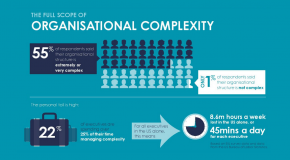At many companies, organisational complexity is a recurring challenge for management, impedes competitiveness and lowers employee morale and retention. Indeed, in a recent survey of executives at large companies around the world, conducted by the Economist Intelligence Unit (EIU), more than half say complexity has cut into their profits over the past three years. Furthermore, 38% of all respondents report that managing complexity occupied 16-25% of their time—time that could have been spent on more productive pursuits—with 17% spending a whopping 26-50% of their workday dealing with complexity. If executives could cut the time they spend managing complexity in half, we estimate that a minimum of 8.6m hours a week could be saved by executives in the US alone—or 45 minutes for every executive every day.
In a remarkable comment on the difficulty of addressing complexity, 8% of respondents say that their company deliberately slowed growth in an effort to reduce complexity. Most had tried a range of other tactics, but reported no more than moderate success.
Where respondents do report success, leadership seems to be the key. The survey findings suggest that leaders who can make the case for taming complexity throughout their organisations and drive adoption of the appropriate tactics for doing so will be best-positioned to reduce complexity’s impact and increase productivity and collaboration.
Complexity is ubiquitous
To shed some light on the causes of and solutions to organisational complexity, the EIU surveyed 331 executives from companies with annual revenue greater than $500m in a variety of industries. The survey, sponsored by SAP, was conducted in July and August 2015.
The findings reveal that complexity is a common feature among large companies, with 55% of respondents saying that their organisational structure is extremely or very complex. (Only 1% of respondents indicate that their organisational structure is not complex at all.) However, a slightly smaller 44% of respondents say their company is very or extremely complex and that it is very or somewhat difficult to get things done.
Perhaps not surprisingly, the survey also suggests a link between size of an organisation and its level of complexity, with a high of 68% of respondents at companies with more than $5bn in annual revenue describing their organisation as extremely or very complex. Further, the number of countries in which a company operates clearly relates to greater complexity, again reaching a high of 67% of respondents at companies with operations in 50 or more countries saying their organisation is extremely or very complex. Among industries, respondents in IT and technology more often than others describe their organisation as extremely or very complex.
Complexity’s sources and effects
While the causes of complexity vary greatly, those most often mentioned by executives are complex decision-making processes (12%) and organisational structure (9%).
Regardless of the source, complexity has a direct impact on the bottom line, respondents say. Fifty-five percent indicate that over the past three years complexity has cut into their organisation’s profits, with 5% saying that profits were affected significantly.
Areas of the organisation most negatively affected by complexity, according to executives, include general management (29%), employee relations (23%), customer service (21%), governance and compliance (19%) and product development (18%). It’s notable that the two areas most frequently cited are not externally facing, perhaps suggesting one reason that complexity can be put on a back burner.
And all that doesn’t include the toll on individual executives, 22% of whom say they’re spending at least one-quarter of their time managing complexity instead of on more productive tasks. In the US, for example, cutting the time wasted by all executives by half would result in reducing wasted hours for each private-company employee each week from at least 7.5 to 3.7 hours. Given the number of top executives in the US, that equals a minimum of 8.6m hours that could be saved each week—or 447 million hours a year.
Trying to tame complexity
Given complexity’s widespread impact, companies report taking a variety of steps to reduce it. Among the most common are promoting a culture of collaboration (39%) and implementing new technology tools or infrastructure (33%). Also cited were creating cross-functional roles to facilitate collaboration, adopting new decisionmaking processes and improving leadership skills—each chosen by 30% of respondents.
But, for the most part, a majority of respondents from the firms that had tried each of these strategies found them to be not entirely successful. Among those businesses that created crossfunctional roles to facilitate collaboration, for example, only 56% of respondents say doing so was most helpful, the highest share of any strategy. Other actions found to be most successful include implementing new decision-making processes and implementing new technology tools or infrastructure (each at 54%).
The primary benefits of all efforts to reduce complexity, respondents say, include more efficient decision-making (51%), increased collaboration (48%) and improved customer satisfaction (30%).
Many efforts to reduce complexity are ultimately unsuccessful—9% of respondents report that none of the methods they had deployed proved to be helpful. The most commonly cited reasons for failure are poor management, a culture resistant to change, a lack of buy-in across the enterprise and too much data or information to manage.
The case for confronting complexity continuously
In addition to the millions of hours executives could save by cutting down the time they spend managing complexity, survey respondents estimated how much reducing complexity could help their companies: just over half indicate that if they could just cut complexity in half, their companies would be at least 11-25% more productive.
This again highlights the importance of leaders making reducing complexity a priority and devoting real time to it.
The survey suggests that leadership decisions on structure and processes, along with follow-through on those decisions, are key and that a failure of leadership or role-modelling likely lies behind many unsuccessful efforts to reduce complexity (as in many unsuccessful efforts to manage change of any kind).
So, the effort to reduce complexity must be driven from the top down, with executive management leading the charge by promoting a culture that favours collaboration and then providing the tools and technologies that enable it. Because no effort can be successful without the ability to measure its impact, it’s necessary to determine metrics that are appropriate for the organisation to gauge success. Finally, leaders need to ensure that reducing complexity remains a priority for everyone, with sound change management ensuring that initial efforts to reduce complexity take root and thrive.






